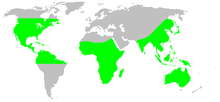| Wandering spiders Temporal range:
| |
|---|---|

| |
| Phoneutria nigriventer | |
| Scientific classification | |
| Domain: | Eukaryota |
| Kingdom: | Animalia |
| Phylum: | Arthropoda |
| Subphylum: | Chelicerata |
| Class: | Arachnida |
| Order: | Araneae |
| Infraorder: | Araneomorphae |
| Family: | Ctenidae Keyserling, 1877 |
| Diversity | |
| 49 genera, 533 species | |

| |
Wandering spiders (Ctenidae) are a family of spiders that includes the Brazilian wandering spiders. These spiders have a distinctive longitudinal groove on the top-rear of their oval carapace similar to those of the Amaurobiidae.[1] They are highly defensive[2] and venomous nocturnal hunters. Wandering spiders are known to hunt large prey, for example hylid species Dendropsophus branneri.[3] Despite their notoriety for being dangerous, only a few members of Phoneutria have venom known to be hazardous to humans, but the venoms of this family are poorly known,[4] so all larger ctenids should be treated with caution.
- ^ McGavin, George C. (2002). Insects and Other Terrestrial Arthropods. New York: Dorling Kindersley Ltd. p. 230. ISBN 0-7894-9392-6.
- ^ Bücherl, Wolfgang; Buckley, Eleanor E. (2013). Venomous Animals and Their Venoms: Venomous Invertebrates. Elsevier. p. 237. ISBN 978-1-4832-6289-5.
- ^ de Araujo Lira, André Felipe (May 26, 2000). "Predation of Dendropsophus branneri (Cochran, 1948) (Anura: Hylidae) by wandering spider (Araneae: Ctenidae) in an Atlantic forest remnant". Herpetology Notes. 13: 421–424 – via Biotaxa.
- ^ Okamoto; et al. (2009). "Ctenus medius and Phoneutria nigriventer spiders venoms share noxious proinflammatory activities". J. Med. Entomol. 46 (1): 58–66. doi:10.1603/033.046.0108. PMID 19198518. S2CID 33154932.